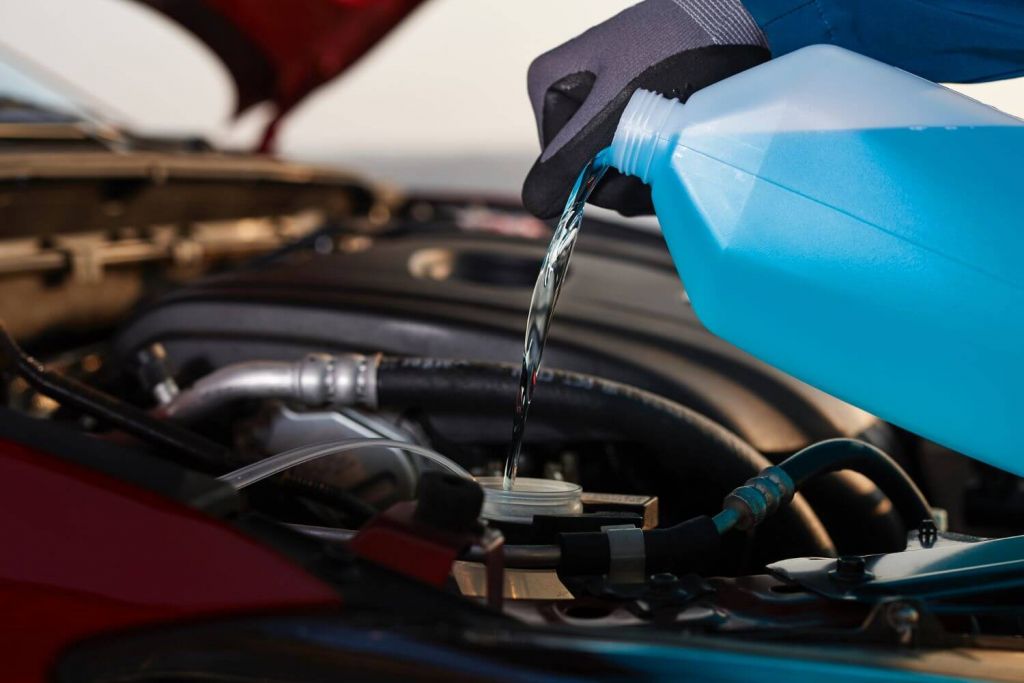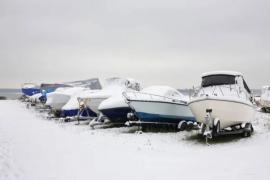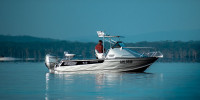Can You Use RV Antifreeze to Winterize a Boat?
When winter closes in and you get ready to winterize your boat, there's a to-do list with several expensive but disposable items like shrink wrap and anti-freeze. At $6.00 to almost $15.00 per gallon in some marine stores, boat antifreeze can add up. When I had my boat in southern New England, I used at least ten gallons every winter.
It's often a dollar or two cheaper than something labeled "marine," but will it work for you?
Can you use RV Antifreeze to winterize a boat? RV antifreeze and marine antifreeze are chemically the same. For most parts of winterizing your boat, RV antifreeze can absolutely do the job for a boat. But there are a few possible caveats, and it won't do for every job you may need - for example, the bilge pump.
This is due to the difference in ratings of some antifreeze. Read on to learn how to protect your boat, where you can use RV antifreeze to save a few of those precious boat-bucks, and where you definitely shouldn't use it.

The Difference Between Antifreeze and Engine Coolant
It's a common misnomer to refer to "engine coolant" as just "anti-freeze." Engine coolant has a different purpose than anti-freeze, though one function it performs reduces freezing risks in engines. It's chemically very different from antifreeze that we'd use in winterizing a boat. Coolant may be labeled and marketed as "Engine Antifreeze/Coolant" but it is a distinct product.

Winterize Your Boat
Engine Coolant
Engine coolant is toxic and should never, ever be used for any aspect of boat winterization. Your boat's engine should have a proper coolant balance, true, but that’s independent of the winterizing process. You may find engine coolants for RV's. These are for RV's with engines, not for the household systems you'd find in the living areas of RV's with or without engines.
One tipoff that you're looking at engine coolant instead of antifreeze is the price - coolant is much more expensive than non-toxic, propylene glycol based anti-freeze. The color is different - green or orange - and there are prominent poison warnings on the label.
Most engine coolant contains Ethylene Glycol or other toxic chemicals and should be used nowhere but in the self contained fresh-water side of your engine cooling system. Never let it leak into the water and clean spills promptly.
Characteristics of Antifreeze
Boat and RV antifreeze comes in different strengths and colors, but there's no standard for what the colors mean. Pink is generally the lowest protection, with darker colors of blue, purple or green meaning more protection. Read the label on any non-marine product to ensure what you are buying is what you need and what you are expecting.
Antifreeze you use on your boat should be:
- Non-toxic. If you are winterizing your drinking water, this is obvious. But even winterizing your engines should be done with non-toxic antifreeze since most of it will be ejected into the water the first time you start the engine for the season. Use no toxic antifreezes which might end up in the water.
- Tasteless and odorless. This is mostly true as manufactures claim. But "the pink stuff" still has a smell. You will want to flush your water tanks to get it all out in the spring. But it’s not a persistent or strong taste or smell.
- Protects to at least -50°F (-45°C). Different protection levels are available, but this is only because of the amount the antifreeze is diluted (more on this later). The more protection, the more expensive the antifreeze.
- Propylene Glycol is the primary ingredient. This effective antifreeze isn't toxic and has minimal taste and odor.
- Have no extra additives which may be toxic or damage systems. Some have non-toxic additives to help protect and preserve seals and fittings; this is fine.
- While recycled propylene glycol antifreeze will work, you may not want to use it in household systems. Check the label, some will state they are made from "virgin" products or mention recycling.
Where does RV Anti-freeze Work Well?
The inexpensive, -50°F burst rated pink RV antifreeze works well in household systems and winterizing the engine. Use it to flush all these systems to clear out the water in the lines and leave a little in the lines, in toiled bowls, tanks and other areas where water accumulates.
Since "RV antifreeze" is the same chemical as "Marine" antifreeze, they are interchangeable. Manufacturers know we've figured this out, and a lot of antifreeze is now labeled sold as a "Marine/RV" product.
When you use RV antifreeze, do not dilute it. The pink -50°F antifreeze is suitable for most winterizing, but it is already diluted and will not be effective if you dilute it further.
Where Shouldn't We use RV Antifreeze
Most of the "RV Antifreeze" you see is the -50°F pink liquid. There are a few spots on a boat where you may want more protection than this provides. Very little RV Antifreeze with a burst point lower than -50°F (-45°C) is sold as "RV Antifreeze," but it's available in marine stores.
Some critical systems like the bilge pump could use a higher level of protection than -50°F. Propylene Glycol will form a slush at low temperatures long before it freezes and expands like water. For -50°F rated antifreeze, this happens at about +12°F (-11°C) . This slush is harder to pump, and if something trips your bilge pump, it could get damaged. A -100°F rated antifreeze has a freeze point of about -60°F (-51°C) and is much less likely to form slush inside your pump.
If you expect extended temperatures below 12°F (-11°C) where you store your boat, consider a better level of freeze protection in other systems, and RV antifreeze may not work for you at all.
What About the Protection Level?
What does that -50°F rating mean? Why are some rated to -100°F or even -200°F? It never gets that cold where you live, right?
Water damages boats when it freezes because it expands. The volume increases by about 9%, and the expansion is powerful enough to crack cast iron and split steel. The purpose of antifreeze is to prevent this freezing by lowering the freezing point of the liquids in your boat. Or by replacing the easy to freeze water by displacing it with a liquid freezes at a much lower temperature.
Freezing, Bursting, and Slush
Manufacturers rate antifreeze at the burst point of a copper pipe. This is the temperature where the undiluted antifreeze product freezes and expands with enough force to split a standard copper pipe. However, antifreeze has a freeze point, which is the temperature where ice crystals form in the liquid.
In propylene glycol based antifreeze, these crystals form a slush at temperatures close to the freezing point, and it doesn't get solid until close to the burst point. The crystals are normaland will not harm your systems. Since a winterized boat is just sitting there, the slush causes no problems until sustained temperatures are near the burst point. It's only when the liquid may circulate that harm may happen, like a slush-filled bilge pump that triggers during a deep freeze.
Antifreeze is a mix of propylene glycol and water, and freeze rating is determined by how much propylene glycol there in the antifreeze. That -100°F rating is the same chemical as the -50°F, except it has a higher ratio of propylene glycol to water.
It isn't necessary to use 100% propylene glycol for antifreeze, as ratios of 60-70% propylene glycol provide enough protection for almost anywhere on earth. However, you can buy concentrated antifreeze and dilute it yourself to the protection you need. This can be more economical, especially if you have to get your antifreeze special ordered or shipped to a more remote location.
Dilution and Freezing Risks
No matter what type of antifreeze you choose, one takeaway is diluted antifreeze gives less protection. For winterizing, you need to take a few steps to make sure you don't under-protect your boat.
The risk is liquid in the lines or tanks. If you still have two gallons of water in your fresh water tank when you add a few gallons of antifreeze to flush the lines, you've cut your protection.
- Fully drain all water systems, lines, tanks and hoses as much as possible before flushing with antifreeze. If practical, blow lines clear with compressed air or a shop vac just to be sure there is no water sitting in them.
- Make sure when you run the antifreeze through a system, you do NOT stop running it the second the antifreeze comes out. The first couple of seconds of antifreeze will be a mix of residual water and antifreeze, so you want to let that run out.
- If you know you can't drain all the water first, consider using a concentrated antifreeze instead of the least expensive stuff. It will cost more, but will still cost less than repairing freeze damage.
Did you find the answer to your specific question?
👍 11 👎 0



Leave a comment